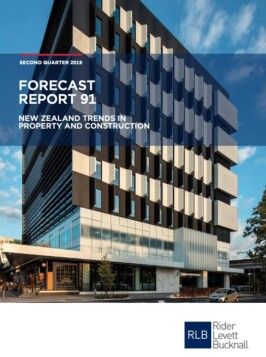The Rider Levett Bucknall (RLB) Forecast 91 report – New Zealand Trends in Property and Construction – released today confirms the combination of robust underlying construction demand and capacity constraints mean that the construction cycle is likely to be even more protracted than previously expected.
Prepared by the New Zealand Institute of Economic Research (Inc.) (NZIER) exclusively for RLB, Forecast 91 shows tighter access to finance may also weigh on construction growth, although lower interest rates improve the feasibility of construction developments.
Many forces buffeting the construction sector
Grant Watkins, Director of RLB in Wellington said, ‘There are many forces buffeting the construction sector. Low operating margins, labour shortages, and uncertainty of cashflow continue to beset construction sector firms.’
‘The issue of the ability and willingness of construction sector firms to bear the risk of cost overruns in the current environment of continued strong upward cost pressures has hampered developments,’ he added.
The strong increase in costs will attract more resources such as workers to the sector, with capacity pressures likely to ease as a result. RLB expects construction cost inflation will moderate from high levels over the coming years.
New retail driving non-residential construction
According to RLB, demand for new retail outlets remained the top driver of non-residential construction growth over the past year, reflecting strong demand in Auckland.
Non-residential construction demand is solid, but the easing in value per square metre of non-residential construction consent issued suggests a moderation in construction cost inflation.
Grant continued, ‘We expect that strong construction cost growth will encourage more resources such as labour to enter the sector, with the easing in capacity pressures leading to slower construction cost inflation over the coming years.’
Demand for storage buildings solid for now
The trade war between the US and China continues to pose downside risks for the global growth outlook and in turn demand for New Zealand exports. This may reduce demand for new storage, industrial and farm buildings.
For now, demand for storage buildings is solid. Over the longer term, robust migration-led population growth and tourist inflows should underpin improved demand for:
- Office growth to accommodate higher numbers of white collar workers
- New accommodation buildings in response to the continued high numbers of international visitors, as well as strong domestic tourism activity
Earthquake strengthening activity should also continue to contribute to non-residential construction demand.
Auckland, Waikato and Otago feel the effects of strong population growth and tourism
Grant concluded, ‘Growth in non-residential construction over the past year remained strongest in Auckland, followed by Waikato and then Otago.’
RLB expects this trend to continue reflecting the effects of strong population growth and tourism
activity in the regions. Meanwhile, growth in nonresidential construction demand in Waikato has been underpinned by stronger demand for social and storage buildings.
RLB New Zealand Trends in Property and Construction Q2 2019
Contact
Grant Watkins
T. +64 4 384 9198
E. grant.watkins@nz.rlb.com
FURTHER INFORMATION:



